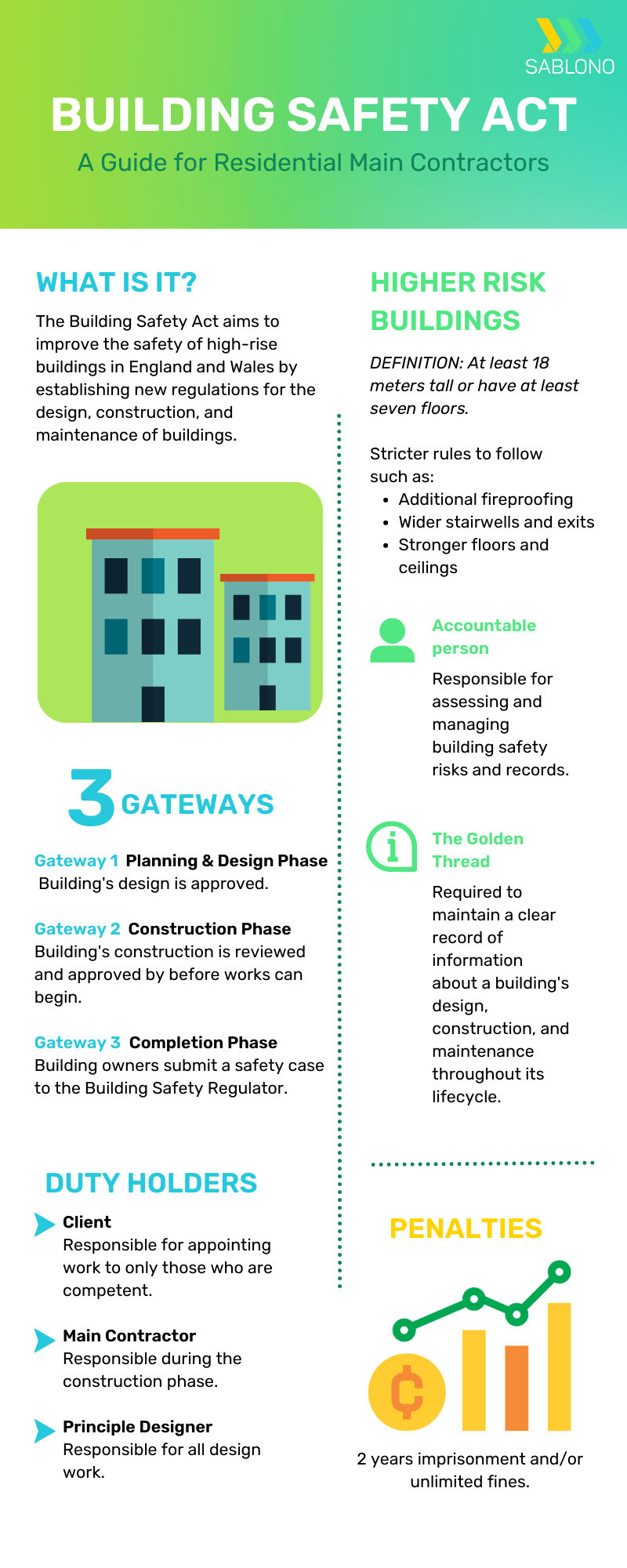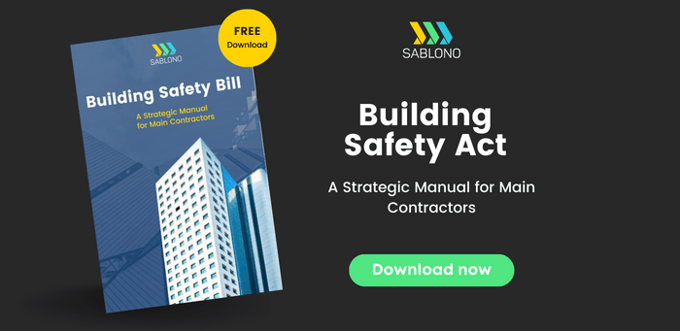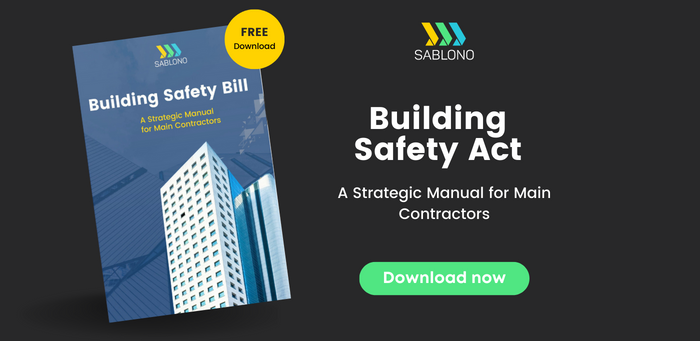The Building Safety Act—a groundbreaking legislation designed to enhance accountability, safety, and quality in the construction industry. In this guide, we will explore the key aspects of the Building Safety Act you need to know to ensure you’re compliant.
Skip to:
- What is the Building Safety Act?
- Who does it apply to?
- When is the deadline?
- Gateways
- Higher-risk buildings
- The golden thread
- Accountability definitions
- Objectives
- Key dates
- Benefits
- The role of digital technology
- How to comply
- Key takeaways
Summary:

What is the Building Safety Act?
The Building Safety Act is a comprehensive law that aims to improve safety standards in the construction industry. It establishes a new set of rules for design, construction, and maintenance, ensuring that buildings are safe and secure.
The Act focuses on holding accountable those involved in the construction process to protect occupants from potential hazards, such as fire and structural failures.
"The Building Safety Act represents a fundamental shift in how we approach building safety, placing a stronger focus on accountability, transparency, and a culture of safety throughout the entire lifecycle of a building." - Dame Judith Hackitt, Building a Safer Future Report Author
Who does it apply to?
The Building Safety Act applies to various stakeholders in the construction industry. This includes building owners, developers, designers, contractors, engineers, building control bodies, and those responsible for ongoing building maintenance and management.
Additionally, the Act addresses higher-risk residential buildings, which require additional scrutiny and specific requirements.
When is the deadline?
Between April 2023 and October 2023.
For compliance with the Building Safety Act, it is necessary to register all buildings covered by the Act with the Building Safety Regulator (BSR). Registrations are expected to take place between April 2023 and October 2023.
The Higher-Risk Buildings (Key Building Information etc.) (England) Regulations 2023 specify the key building information that must be submitted within 28 days of registering the building or by 30 September 2023, whichever is later.

Gateways
The Building Safety Act incorporates three checkpoints, known as gateways, to ensure building safety throughout the construction process. Gateways are critical stages in the building process where independent checks and inspections are conducted and each must be approved before the project can progress.
- Planning Gateway: Occurring during the design phase, plans are reviewed and approved by the local authority or building control body.
- Construction Gateway: Inspections are conducted at a specific stage to ensure compliance with approved plans and safety regulations.
- Completion Gateway: A comprehensive inspection is carried out to verify that the building meets all required safety standards before completion.
Higher-Risk Buildings
The Building Safety Act introduces specific provisions for higher-risk residential buildings (HRRB) are defined as new or existing high-rise residential properties that are at least 18 metres in height, or have at least 7 storeys, and have at least two residential units.
These buildings will undergo stricter safety measures, regular inspections, and requirements for information management and the appointment of accountable persons.
- Reinforcements around doors and windows.
- Additional fireproofing of structural elements, and sprinkler systems throughout the building.
- Wider stairwells and exits, and stronger floors and ceilings.
- Accountable person - This person will have legal duties for assessing and managing building safety risks, keeping records, and providing safety information to residents, building owners, and the Building Safety Regulator.
- The Golden Thread - The golden thread concept is a significant feature of the Building Safety Act. It refers to a digital record of a building's design, construction, and ongoing maintenance information. The golden thread ensures crucial safety information is captured and easily accessible throughout the building's life cycle. This facilitates effective oversight, inspection, and remediation.
For higher-risk buildings, it is required to maintain a clear record of information about a building's design, construction, and maintenance throughout its lifecycle, to ensure ongoing safety and regulatory compliance.
Accountability Definitions
To ensure clear lines of accountability, the Building Safety Act introduces several important definitions, including:
- Duty Holders: Individuals or organisations responsible for specific duties at different stages of a building's life cycle.
- Accountable Person: The individual or entity responsible for overall safety and compliance of a higher-risk building.
- Building Safety Manager: A designated person responsible for day-to-day management of building safety measures.
Key Objectives
The Building Safety Act has several primary objectives, including:
- Enhancing accountability and clearly defining responsibilities for building safety.
- Strengthening regulations for high-rise and high-risk buildings.
- Improving competence and professionalism in the construction industry.
- Establishing a robust system for oversight, regulation, and enforcement.
- Enhancing transparency of safety information for residents and building occupants.
Key Dates
The Building Safety Act implementation follows a phased approach, with important dates to remember, including:
- April 2023: Registration opens for existing occupied High-rise Residential Buildings (HRB).
- October 2023: Deadline for registration of existing occupied buildings. All new buildings must be registered before occupation. Building inspector and building control approver registration begins. The Building Safety Regulator (BSR) becomes the new building control authority for High-rise Residential Buildings. Developers must seek building control approval from BSR before starting work on any HRB.
- April 2024: BSR initiates building assessments and issues Building Assessment Certificates. Requirements for registration of building inspectors and building control approvers become enforceable.
Benefits of the Building Safety Act
Implementing the Building Safety Act brings numerous benefits, such as:
- Increased safety standards, reducing the risk of fire, structural failure, and other hazards.
- Improved accountability, ensuring the right individuals and organisations are responsible for building safety.
- Enhanced transparency and access to safety information for residents.
- Greater competence within the construction industry.
- A stronger regulatory framework to prevent future building safety incidents.
The Role of Digital Technology in Building Safety Act Compliance
Golden Thread Information Management: The Act introduces the golden thread concept, which involves keeping a digital record of design, construction, and maintenance information. Creating the golden thread allows for easy access to comprehensive building data, making building management more convenient and effective.
{We created Sablono to seamlessly integrate the golden thread in your projects. Our digital audit trail provides a fully automated, accountable record of everything that happens on your project. Learn more here: Quality Audit Trail}
Digital Building Information Modeling (BIM): BIM technology creates and manages detailed 3D digital models of buildings. It helps in planning, design, construction, and maintenance, providing a collaborative platform for stakeholders to visualise and share building information. BIM improves communication, coordination, and accuracy in implementing safety measures.
Digital Building Control Approvals: Developers may need to seek building control approval through digital platforms. This simplifies the application and review process, allowing for efficient communication between developers, building control bodies, and regulatory authorities. Digital platforms ensure faster and more accurate approvals, ensuring compliance with safety regulations.
Digital Reporting and Compliance Monitoring: The Act may introduce digital reporting mechanisms to monitor building safety and compliance. Digital platforms enable data collection, analysis, and reporting on building inspections, assessments, and remediation activities. This promotes transparency, accuracy, and effective monitoring of safety standards.
Digital Fire Safety Systems: Advanced digital fire safety systems, including fire detection, alarm, and suppression systems, are essential for building safety. These systems utilise digital technology to detect and respond to fire hazards swiftly, providing early warnings and facilitating rapid emergency response.

How Do I Comply with Building Safety Act?
Preparing for compliance with the Building Safety Act involves several important steps:
- Understand the Act
Familiarise yourself with the Building Safety Act and its requirements. Read through the legislation, regulations, and guidance documents to gain a comprehensive understanding of your obligations. - Identify Applicable Buildings
Determine which buildings fall within the scope of the Act. This typically includes higher-risk buildings such as tall or complex structures. Ensure you have a clear inventory of the buildings that need to be addressed. - Assess Current Safety Measures
Conduct a thorough assessment of your existing buildings' safety measures. Identify any gaps or areas that require improvement to meet the Act's standards. Consider engaging professionals such as fire safety experts or building inspectors to assist with the evaluation. - Establish Compliance Processes
Develop robust processes and procedures to ensure ongoing compliance with the Act. This includes implementing systems for monitoring and maintaining safety standards, record-keeping, and communication with relevant authorities.
{Need help complying? Sablono's construction compliance software can help. Learn more here: Sablono for construction compliance} - Register with the Building Safety Regulator (BSR)
Follow the registration requirements outlined by the Act. Register all applicable buildings with the BSR within the specified timeframe. Stay informed about the registration process and any associated deadlines. - Gather and Submit Building Information
Collect and organise the necessary building information as required by the Act. This may include design plans, construction records for the golden thread, maintenance documentation, and fire safety strategies. Ensure the information is accurate, up to date, and readily accessible for future reference. - Stay Updated on Guidance and Regulations
Keep track of any guidance or regulations issued by the BSR or other relevant authorities. Regularly check for updates and ensure that your compliance practices align with the latest requirements. - Train Staff and Raise Awareness
Educate your staff and relevant stakeholders about the Building Safety Act, its implications, and their responsibilities. Provide training on safety protocols, reporting procedures, and any specific requirements outlined in the Act. - Engage with Professionals
Consider seeking professional assistance from experts in building safety, fire safety, or regulatory compliance. Their expertise can help ensure that your buildings meet the necessary standards and requirements. - Monitor Changes and Adapt
Continuously monitor developments related to the Building Safety Act. Stay informed about any updates, amendments, or new obligations that may arise. Be prepared to adapt your processes and practices accordingly.
Key Takeaways from the Building Safety Act
Stronger Safety Standards: The Building Safety Act introduces stricter safety standards to ensure the well-being of occupants in buildings, especially those at higher risk.
Clear Accountability: The Act defines clear roles and responsibilities for building owners, developers, designers, and building control bodies, emphasising the importance of accountability and compliance with safety regulations.
Digital Information Management: The Act promotes the concept of the "golden thread," which means maintaining a digital record of design, construction, and maintenance information. This helps in effective building management and ensures critical safety information is easily accessible.
Independent Checks at Gateways: The Act establishes gateways in the building process where independent inspections and assessments occur to ensure compliance with safety standards. These checkpoints maintain a high level of safety throughout construction.
Focus on Higher-Risk Buildings: Special attention is given to higher-risk buildings, such as tall or complex structures. The Act introduces additional safety measures, frequent inspections, and specific requirements for fire safety and structural integrity.
Resident Engagement and Transparency: The Act emphasises the involvement of residents and promotes transparency in higher-risk buildings. Building owners must provide clear information on safety measures, evacuation procedures, and any ongoing remediation work to keep residents informed and address their concerns.
Collaboration and Coordination: Building safety is a joint effort involving various stakeholders, including owners, developers, designers, contractors, and building control bodies. The Act encourages collaboration and coordination among these parties to foster a safety-focused culture and ensure compliance with regulations.
Want to learn more about what the Building Safety Act means for you as a residential main contractor? We’ve created a strategic guide to help. Download your copy below.


